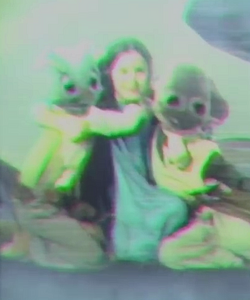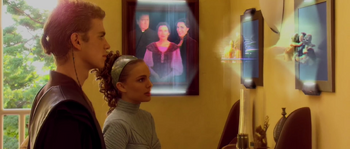| | |
- "That was when I went with a relief group to Shadda-Bi-Boran. Their sun was imploding and the planet was dying. I was helping to relocate the children."
- ―Padmé Amidala, explaining a holograph of her younger self to Anakin Skywalker
Shadda-Bi-Boran was an Outer Rim planet inhabited by a sentient species of the same name. It had three moons and contained plains and swamps. Shadda-Bi-Boran orbited the sun Shadda, which had reached its white dwarf phase by the decline of the Galactic Republic. The resulting implosion threatened the Shadda-Bi-Borans, who had a purifying enzyme only activated by Shadda's sunlight.
Fundraising and research efforts throughout the galactic community to find a substitute for the Shadda-Bi-Borans' enzyme or a suitable new star failed. In 38 BBY, as Shadda-Bi-Boran began to freeze over, the Refugee Relief Movement sent volunteers to evacuate the population in the hope that some distant planets would have appropriate conditions for the species. The final Shadda-Bi-Borans were evacuated as the planet froze, and ultimately the species was unable to adapt elsewhere and went extinct.
Description[]
Shadda-Bi-Boran was a terrestrial planet located in the Shadda-Bi-Boran system of the Bi-Boran Cluster,[1] a part of the Toblain sector[2] in the Trailing Sectors portion of the Outer Rim Territories. The planet had three moons and held the second orbital position around the sun Shadda. A day on Shadda-Bi-Boran lasted sixteen hours, while a local year lasted 271 days. The planet had a diameter of 9,100 kilometers, and its surface featured plains and swamps.[1]
History[]
- "They were never able to adapt, they were never able to live off their native planet."
- ―Padmé Amidala, on the Shadda-Bi-Borans
The Shadda-Bi-Borans were a sentient species native to the planet of the same name. The species developed a toxin-cleansing enzyme activated by the radiation from Shadda's sunlight. Eons before the final years of the Galactic Republic, Shadda transformed from a red giant into a white dwarf, a process that led to cataclysmic weather events and major groundquakes on Shadda-Bi-Boran. Astrophysicists eventually predicted that Shadda would soon cease to generate enough radiation to prevent Shadda-Bi-Boran from freezing over and releasing its atmosphere into space.[1]

Padmé Naberrie (center) alongside two Shadda-Bi-Boran children during the planet's evacuation effort
The Shadda-Bi-Borans were initally unable to be evacuated from their homeworld due to their dependence on Shadda's light. Kerchiefs made of Shadda silk were sold throughout the galaxy, with the proceeds divided between researching a substitute for the enzyme and finding another star that matched Shadda's characteristics. In 38 BBY, the planet's death became final[1] as Shadda imploded,[3] and volunteers from the Refugee Relief Movement, among them the Naboo Padmé Naberrie, arrived on Shadda-Bi-Boran. They intended to evacuate the population in the hope that some distant stars would give rise to suitable planetary conditions for the species. However, none survived. A final refugee ship carrying one hundred Shadda-Bi-Borans departed the planet as it froze over. Upon hearing that the rest of their species had died, the survivors refused pleas to go into stasis or carbon-freezing, and all had perished within months of the demise of their planet.[1]
In 22 BBY,[1] while traveling to her home planet Naboo disguised as a refugee aboard the AA-9 Coruscant freighter Jendirian Valley, Naberrie, by then known as Padmé Amidala, remembered her time on Shadda-Bi-Boran for the first time in years.[4] At her childhood home on Naboo, Amidala described the fate of Shadda-Bi-Boran to the Jedi Padawan Anakin Skywalker.[3]
Inhabitants[]
- "See that little one I'm holding? His name was N'a-kee-tula, which means "sweetheart." He was so full of life—all those kids were."
- ―Padmé Amidala, explaining a holograph featuring her and N'a-kee-tula to Anakin Skywalker
Shadda-Bi-Boran was inhabited by the green-skinned Shadda-Bi-Borans, a primitive peaceful species that was governed by a theocratic sun priest caste. The Shadda-Bi-Borans comprised ninety-three percent of the population, with immigrated species making up the remaining seven percent. Shadda-Bi was the planet's native language, with Galactic Basic Standard also being spoken there. The main export of Shadda-Bi-Boran was textiles, including Shadda silk, and the planet had no major imports.[1] During the Shadda-Bi-Boran exodus, Amidala met the Shadda-Bi-Boran child N'a-kee-tula and recalled him and the other children as being full of life.[3]
Behind the scenes[]
- "Pre-implosion, Shadda-Bi-Boran appears to have been a charming, happy world. Anything less just wouldn't provide the needed dose of pathos in light of its tragic destruction."
- ―Daniel Wallace, commenting on Shadda-Bi-Boran in Star Wars Insider

Anakin Skywalker and Padmé Amidala discuss the latter's time on Shadda-Bi-Boran in a deleted scene.
Shadda-Bi-Boran was created for the backstory of Padmé Amidala for the prequel trilogy film Star Wars: Episode II Attack of the Clones, written and directed by George Lucas. It was mentioned prominently in early versions of the script, but those mentions were reduced throughout the writing process. By the time the scene set in Amidala's childhood bedroom was filmed[5] on August 25, 2000,[6] the dialogue that mentioned Shadda-Bi-Boran had been reduced to an indirect reference.[5]
The planet was first directly mentioned in the film novelization written by R. A. Salvatore,[3] and in the illustrated version of the film's screenplay included in The Art of Star Wars Episode II: Attack of the Clones,[7] both of which were published on April 23, 2002.[8][9] The scene in the film that mentioned the planet was ultimately cut from the final release,[10] which premiered on May 16, 2002.[11] The deleted scene was included on the DVD release of Attack of the Clones, which launched on November 12, 2002.[12]
The eightieth issue of the Star Wars Insider magazine,[5] which began shipping to subscribers by January 14, 2005 and to newsstands by January 31,[13] included the article "The Unseen Planets of Episode II" by Daniel Wallace. It discussed Shadda-Bi-Boran and its deletion from Attack of the Clones. Wallace described the planet's name as sounding like a doo-wop lyric from the musical group The Marcels. The article speculated that the planet had been a charming and pleasant place prior to its destruction and that it either became a lifeless husk or a shattered asteroid field. Wallace suggested that the planet having anything other than a happy environment would not have led to an appropriately tragic impact.[5] Shadda-Bi-Boran was first visually depicted in the 2009 reference book The Essential Atlas by Wallace and Jason Fry, which placed the planet in grid square O-18.[1] Fry expanded on the planet's tragic fate and described the galactic community's efforts to save it in order to add depth to Amidala's backstory.[14]
Appearances[]
- Darth Plagueis (Mentioned only)
- Darth Plagueis audiobook (Mentioned only)
- Star Wars: Episode II Attack of the Clones novelization (First mentioned, simultaneous with The Art of Star Wars Episode II: Attack of the Clones)
- Star Wars: Episode II Attack of the Clones unabridged audiobook (Mentioned only)
- Star Wars: Episode II Attack of the Clones junior novelization (Mentioned only)
- Star Wars: Episode II Attack of the Clones (In deleted scene(s)) (Indirect mention only)
 BREAKING NEWS: Amidala Alive — HoloNet News Vol. 531 #56 (content now obsolete; backup link) (Mentioned only)
BREAKING NEWS: Amidala Alive — HoloNet News Vol. 531 #56 (content now obsolete; backup link) (Mentioned only)
Sources[]
- The Art of Star Wars Episode II: Attack of the Clones
- The New Essential Guide to Characters
- The Official Star Wars Fact File 80 (NAB2, Jobal Naberrie)
 "The Unseen Planets of Episode II" — Star Wars Insider 80
"The Unseen Planets of Episode II" — Star Wars Insider 80- Star Wars: The Ultimate Visual Guide
- The Complete Star Wars Encyclopedia
- The Essential Atlas (First pictured)
 Star Wars: The Essential Atlas Online Companion on StarWars.com (article) (backup link)
Star Wars: The Essential Atlas Online Companion on StarWars.com (article) (backup link)- Star Wars: The Official Starships & Vehicles Collection 36 (Welcome On Board: Queen Amidala: Leadership in Dangerous Times)
- Star Wars: Edge of the Empire Core Rulebook
- The Official Star Wars Fact File Collector's Guide & Galaxy Chart
- Star Wars: Age of Rebellion Core Rulebook
- Star Wars: Force and Destiny Core Rulebook
Notes and references[]
- ↑ 1.00 1.01 1.02 1.03 1.04 1.05 1.06 1.07 1.08 1.09 1.10 1.11 1.12 1.13 1.14 1.15 1.16 1.17 1.18 1.19 1.20 1.21 1.22 1.23 1.24 1.25 1.26 1.27 1.28 1.29 1.30 The Essential Atlas
- ↑ 2.0 2.1
 Star Wars: The Essential Atlas Online Companion on StarWars.com (article) (backup link) — Based on corresponding data for Shadda-Bi-Boran system
Star Wars: The Essential Atlas Online Companion on StarWars.com (article) (backup link) — Based on corresponding data for Shadda-Bi-Boran system
- ↑ 3.0 3.1 3.2 3.3 3.4 3.5 3.6 Star Wars: Episode II Attack of the Clones novelization
- ↑ Star Wars Episode II: Attack of the Clones junior novelization
- ↑ 5.0 5.1 5.2 5.3 5.4
 "The Unseen Planets of Episode II" — Star Wars Insider 80
"The Unseen Planets of Episode II" — Star Wars Insider 80
- ↑ Mythmaking: Behind the Scenes of Attack of the Clones
- ↑ The Art of Star Wars Episode II: Attack of the Clones
- ↑
Attack of the Clones Novelization in the StarWars.com Cargo Bay (content now obsolete; backup link)
- ↑
 Book Preview: The Art of Episode II on StarWars.com (content now obsolete; backup link)
Book Preview: The Art of Episode II on StarWars.com (content now obsolete; backup link)
- ↑ Star Wars: Episode II Attack of the Clones
- ↑ Star Wars Year By Year: A Visual History, New Edition
- ↑
 Episode II On DVD & VHS on StarWars.com (content now obsolete; backup link)
Episode II On DVD & VHS on StarWars.com (content now obsolete; backup link)
- ↑
 Clone Wars Continue in Insider #80 on StarWars.com (content now obsolete; backup link)
Clone Wars Continue in Insider #80 on StarWars.com (content now obsolete; backup link)
- ↑
Daniel Wallace's Geekosity — Endnotes for Star Wars: The Essential Atlas (part 3 of 5) on Blogspot (backup link)
